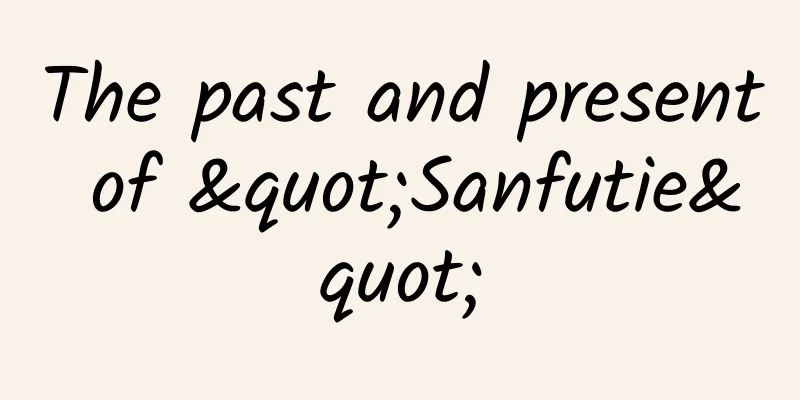The past and present of "Sanfutie"

|
Author: Yang Yingzhan, Institute of Chinese Materia Medica, China Academy of Chinese Medical Sciences Reviewer: Zhang Wei, Researcher, Institute of Chinese Materia Medica, China Academy of Chinese Medical Sciences As we all know, "Sanfutie" as a traditional Chinese medicine has always been loved by the masses and is now widely used in clinical practice. However, ordinary people often do not know enough about what "Sanfutie" is, what specific effects it has, how to use it, etc., which leads to some one-sided understandings, such as thinking that "Sanfutie" can be applied to anyone and for any disease, etc. Sometimes, if people who are not suitable for applying it apply it, it will not only be unhelpful in the treatment of the disease, but may also damage their health. Therefore, this article will help you understand the past and present of "Sanfutie" from three aspects: what is "Sanfutie", what is its use, and how to use it. 1. What is “Sanfutie”? What exactly is “Sanfutie” and why is it used in clinical treatment of traditional Chinese medicine? First of all, we have to start with its name "Sanfutie". "Sanfu" means the first, middle and last fu days, which is the general name of the "three fu days" commonly said by the people. It is calculated according to the ancient calendar, and the third, fourth and fifth Geng days after the summer solstice of that year are set as the first, middle and last fu days. The so-called Geng day is the day of Geng in the Ganzhi calendar. However, since the time of the first fu day is different every year, the middle fu day can have two Geng days, or 10 days, or 20 days. For example, the summer solstice in 2023 is June 12, and the time of the first, middle and last fu days is July 11-20, July 21 to August 9, and August 10-19, a total of 40 days. "Tie" refers to the application method in traditional Chinese medicine. The application method has a long history. It was recorded in the unearthed pre-Qin medical book "Fifty-two Disease Prescriptions". After that, it went through generations of development. In the Qing Dynasty, the famous doctor Zhang Lu formally combined "Sanfu" with "Tie" in his book "Zhang's Medical Encyclopedia". The original text records that "During the three hot days in summer, the application method of white mustard seeds is often effective." In short, "Sanfutie" is the specific application of the application method of traditional Chinese medicine in the three hot days. Figure 1 Copyright image, no permission to reprint Why does traditional Chinese medicine combine the "dog days" with the "sticking method" and not in other time periods? This requires an analysis of the TCM theory on which it is based. The theory based on which "Sanfutie" is based is the TCM "treating winter diseases in summer". TCM believes that winter is yin and summer is yang. "Winter diseases" refer to certain cold and asthenic diseases that are prone to occur in winter or are easily aggravated in winter. Because the body has always been deficient in yang, and the external climate in winter is yin-dominant and yang-deficient, the righteous qi cannot expel evil from the outside, or the yin and cold evil are severely affected, causing some chronic diseases or symptoms, such as chronic cough, asthma, wheezing, chronic diarrhea, cold and painful joints, fear of cold, weak body and susceptibility to cold, which recur or worsen. "Treatment in summer" refers to the treatment measures such as warming and replenishing yang, dispersing cold and expelling evil, and activating blood circulation and unblocking collaterals during the three-fu season in summer, when the yang energy of nature and the body is the most prosperous. On the one hand, it can enhance the body's ability to resist pathogens, and on the other hand, it can help to eliminate yin and cold pathogens, thereby achieving the purpose of treating or preventing the above-mentioned diseases that are prone to occur or aggravate in winter. In fact, "treating winter diseases in summer" is a saying today, but its roots are in the classic Chinese medicine book "Huangdi Neijing", which was developed based on the ancient people's idea of nourishing yang in spring and summer. "Nourishing yang in spring and summer" is one of the principles of Chinese medicine to maintain health according to the seasons. In spring and summer, the yang energy in nature rises, and health practitioners should follow the seasons and protect the yang energy in the body to keep it abundant. At this time, through various methods such as acupoint application, moxibustion, thread embedding, and oral medication, the meridian acupoints are stimulated or the penetration and absorption of drugs are absorbed to achieve the effect of dredging the meridians, regulating the internal organs, and warming and replenishing the yang energy. Therefore, tracing back to the origin, today's "Sanfutie" form officially appeared in the Qing Dynasty, and the theory of "treating winter diseases in summer" originated from the view of "nourishing yang in spring and summer" in "Huangdi Neijing". Figure 2 Copyright image, no permission to reprint 2. What is the use of “Sanfutie”? The efficacy of "Sanfutie" can be roughly grasped from the two words "total" and "part". "Total" refers to the overall efficacy of "Sanfutie". According to the above "Sanfutie" we can understand that "Sanfutie" can make the body's yang rise in spring and summer, thereby inspiring and stimulating the body's yang, that is, the effect of replenishing yang and assisting yang. Therefore, in theory, all yang deficiency diseases and yin cold stagnation diseases can be prevented and treated with "Sanfutie" in clinical practice. "Fen" means "specific efficacy", which mainly depends on the specific medicines used in the "Sanfutie" and the specific acupoints applied. Generally speaking, most of the drugs used in "Sanfutie" have warm properties, which is consistent with the overall application of "Sanfutie", such as white mustard, ginger, asarum, cinnamon, etc. There are two main principles for selecting drugs with warm properties: one is to take the warm effect of the drug to warm the meridians and dispel cold; the other is to take the warm property of the drug to stimulate local acupoints to stimulate the qi of the meridians. Of course, in clinical use, it can also be flexibly added or subtracted according to the specific situation of the person applying the patch. For example, the drug formula for treating lung diseases is mainly composed of white mustard, asarum, ginger, aster, and beam dry, which has the effects of warming yang and dispersing cold, relieving cough and reducing phlegm; the drug formula for treating joint pain is mainly composed of Chuanwu, Caowu, Yanhusuo, Fangfeng, etc., which has the effects of warming the meridians and dispersing cold, promoting blood circulation and relieving pain; the drug formula for treating spleen and stomach diseases is mainly composed of Evodia rutaecarpa, Morinda officinalis, cinnamon, and dried ginger, which has the effects of warming the spleen and stopping diarrhea. Clinically, Chinese medicine can also be used as a reference to add or subtract medicines according to symptoms. For example, if the patient has severe water retention, add Ginseng and Corydalis to dredge the meridians, drain water retention, make the water flow and eliminate phlegm; if the cough and asthma are severe, add Ephedra and Schisandra chinensis to restore the lung's function of descending; if the heat is severe, add borneol; if the body is weak, add Astragalus and Epimedium, etc. The selection of acupoints can be generally based on the theory of viscera and meridians in traditional Chinese medicine, but in clinical practice, the foot-sun bladder meridian and the governor vessel are generally used as the main points. The "foot-sun bladder meridian" is one of the twelve meridians that runs only in the back of the human body. It runs for a long time and is widely distributed. It is also the meridian with the most acupoints in the human body. The "governor vessel" runs in the middle of the back of the human body. It is one of the eight extraordinary meridians and the sea of yang meridians. The combination of the two can enhance the effect of "treating winter diseases in summer". In clinical practice, it can also be selected according to the specific situation of the patient, such as Dazhui, Feishu, Fengmen, Tiantu, Dingchuan, and Shenshu for lung diseases; Zhongwan, Zhiyang, and Mingmen for spleen and stomach deficiency and cold; Shenshu, Mingmen, Guanyuan, and Shenque for kidney yang deficiency. Figure 3 Copyright image, no permission to reprint Modern "Sanfutie" is mainly used for the prevention and treatment of lung diseases, but it is not limited to lung diseases. Depending on the selected drugs and acupoints, it can be used to prevent and treat diseases in various clinical departments, but it needs to be used under the guidance of corresponding doctors. Lung diseases: colds due to physical weakness, chronic cough, asthma, allergic rhinitis, etc.; pain diseases: rheumatism and rheumatoid arthritis, ankylosing spondylitis, frozen shoulder, cervical and lumbar spondylosis; spleen and stomach diseases: chronic gastritis, abdominal pain and diarrhea due to deficiency and cold, etc.; men's diseases: impotence, spermatorrhea, premature ejaculation, etc.; gynecological diseases: dysmenorrhea, uterine cold and infertility, etc.; sub-health conditions: yang deficiency constitution, qi deficiency constitution, etc.; pediatric diseases: recurrent respiratory tract infections, childhood bronchial asthma, chronic cough in children, enuresis, drooling, etc. 3. How to apply the “Sanfutie”? How to correctly apply "Sanfutie" is first of all to choose the time of application. Generally speaking, it can be applied during the period of the beginning of the fu, but "Sanfutie" has a course of treatment, so it needs to be applied once in the "first fu", "middle fu" and "last fu". Taking 2023 as an example, the first application should be applied from July 11 to 20 in the first fu, and according to the application time, it should be applied once every ten days. But now, due to the evolution of the form, there are other application methods such as strengthening the middle fu and strengthening the last fu. Taking 2023 as an example, the first fu is from July 11 to 20, the middle fu is from July 21 to 30, the middle fu is strengthened from July 31 to August 9, the last fu is from August 10 to 19, and the last is strengthened from August 20 to 29. "Strengthening" means that the number of applications is increased to enhance the efficacy of "Sanfutie". Another time is how long it takes to remove the "Sanfu stickers" after they are applied to the human body. Generally, the application time is 2 to 4 hours for adults and 1 to 2 hours for children. The specific application time can be determined based on the patient's condition and constitution, but it should not exceed 6 hours at most. The application time should be determined when the patient feels that the skin is burning and cannot be tolerated. It is normal for the local skin to itch and turn red. If blisters appear, they need to be properly treated. For small blisters, apply scald ointment, and for large blisters, go to the hospital. The second is the precautions when applying the "Sanfu Paste". During the period of using the "Sanfu Paste", you should avoid certain foods and not eat too much spicy and stimulating food, as well as raw and cold seafood. You should also pay attention to your daily life. Cold water bathing, swimming, and sun exposure are prohibited within 24 hours on the day of application. In addition, due to the therapeutic nature of "Sanfutie" to replenish yang and assist yang, although it is widely used clinically, it is not suitable for all diseases and should be selected correctly according to the physical condition of the person applying the patch. For example, patients with serious heart, brain, liver, kidney and other diseases, patients with malignant tumors, people with severe allergic reactions, people with skin ulcers, patients in the outbreak period of the disease, pregnant women, infants and young children, people with yin deficiency and hyperactivity of fire, and severe internal heat are not suitable for using "Sanfutie" for clinical prevention and treatment. In short, "Sanfutie" is also a kind of Chinese medicine diagnosis and treatment. Therefore, it should be carried out under the guidance of a doctor when it is used specifically. |
<<: Is it true that in a lion family, the dad eats first before the mom and the cubs can eat?
>>: When launching rockets, why are liquid oxygen and methane more advantageous?
Recommend
Real-life version of the "Spirit Pearl"? The blue-blooded "noble" in the ocean is actually this →
"Color is part of the language of film"...
Smartphones will disappear in five years, says survey
According to CNBC, a new consumer survey shows th...
2016 Christmas advertising video collection 1: Warmth makes winter no longer cold!
The annual Christmas is coming soon in this cold ...
Li Yue's "How to Improve Emotional Intelligence" teaches you how to develop your own high emotional intelligence
Personal Development Training Course Video Lectur...
6 great templates for advertising creativity!
Many people think that creativity is mysterious a...
Content operation: 3 major driving forces of high-quality UGC!
There are three major driving forces for high-qua...
Brand Promotion and Marketing丨How to make users remember your brand?
You may remember two things: Because Fan Xiaoqin ...
Don’t ever say you don’t know these 13 wild cat species in China!
Cats are one of the most charming animals in natu...
How much does it cost to develop a small moving program in Changsha?
According to industry insiders, mini programs wil...
What? High heels were invented for men!
I believe that every girl had a wish when she was...
Competitive product analysis report: Bilibili VS A-station & TikTok
This article is a competitive product analysis re...
【Practical】A complete collection of commonly used auxiliary tools for APP promotion!
Some people say that App promotion is hard work. ...
"Arts and Sciences" in the Television Industry
As the iteration of TV products accelerates, TV m...









